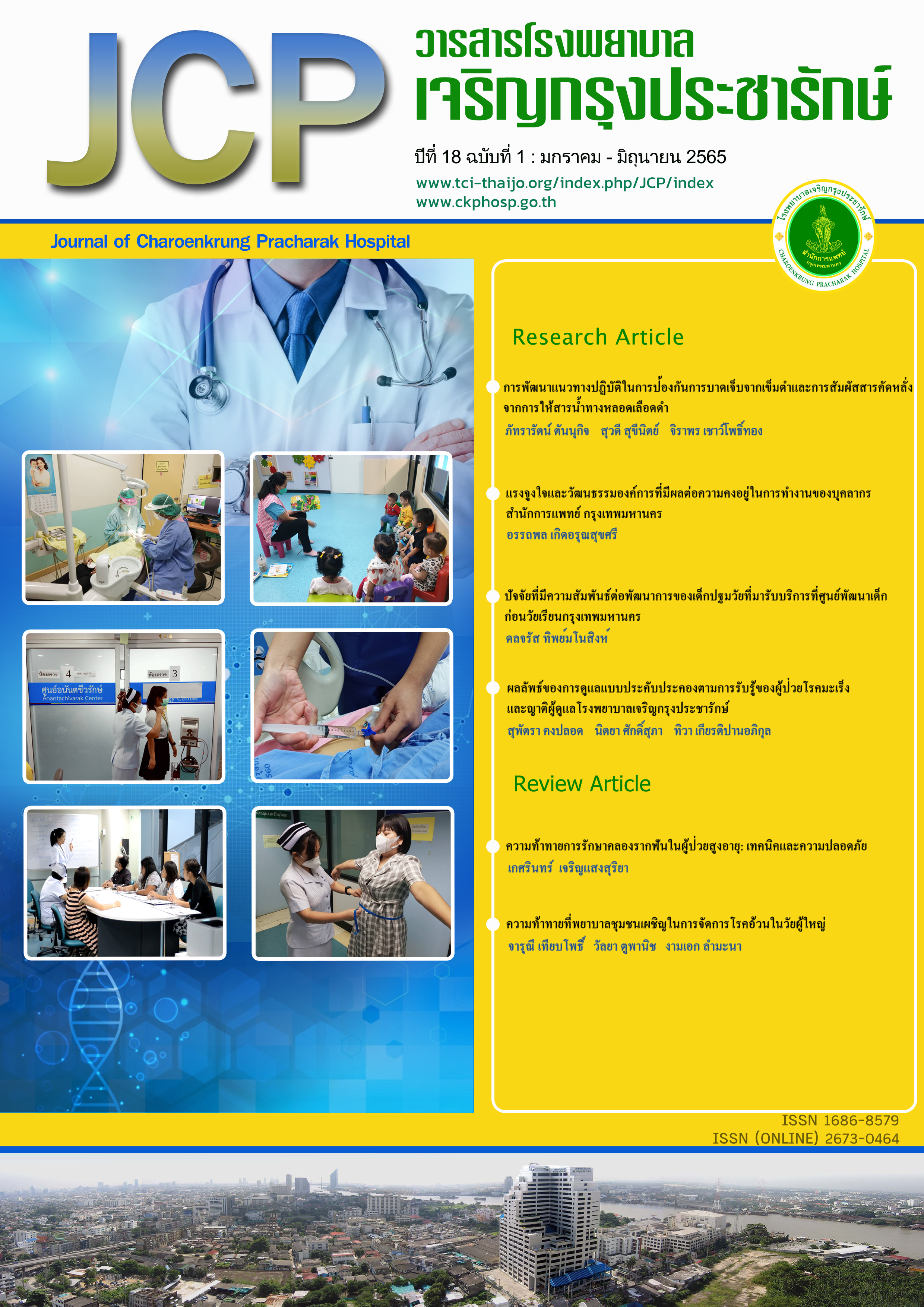ปัจจัยที่มีความสัมพันธ์ต่อพัฒนาการของเด็กปฐมวัยที่มารับบริการที่ศูนย์พัฒนาเด็กก่อนวัยเรียนกรุงเทพมหานคร
Main Article Content
บทคัดย่อ
วัตถุประสงค์:ศึกษาปัจจัยที่มีความสัมพันธ์ต่อพัฒนาการของเด็กปฐมวัยและสถานการณ์พัฒนาการเด็กปฐมวัยที่มารับบริการที่ศูนย์พัฒนาเด็กก่อนวัยเรียนกรุงเทพมหานคร
วิธีดำเนินการวิจัย: ศึกษาวิจัยเชิงปริมาณ ชนิดการศึกษาภาคตัดขวาง ใช้วิธีการสุ่มตัวอย่างแบบหลายขั้นตอน จำนวน450 คนจากศูนย์พัฒนาเด็กก่อนวัยเรียนกรุงเทพมหานคร6 กลุ่มเขต โดยประเมินพัฒนาการเด็กจากคู่มือเฝ้าระวังและส่งเสริมพัฒนาการเด็กปฐมวัย (DSPM)และคู่มือการประเมินและส่งเสริมพัฒนาการเด็กกลุ่มเสี่ยง (DAIM) ข้อมูลทั่วไปและปัจจัยที่เกี่ยวข้องกับพัฒนาการเด็กได้จากการสัมภาษณ์และสมุดบันทึกสุขภาพแม่และเด็ก วิเคราะห์ข้อมูลด้วยสถิติร้อยละ และการวิเคราะห์การถดถอยโลจิสติก เก็บข้อมูลระหว่างเดือนมีนาคมถึงสิงหาคม พ.ศ.2563
ผลการวิจัย:เด็กมีพัฒนาการล่าช้าร้อยละ 22.67 แบ่งเป็น ด้านความเข้าใจภาษามากที่สุดถึงร้อยละ 27.45 รองลงมาคือด้านกล้ามเนื้อมัดเล็ก ร้อยละ 24.51 ปัจจัยที่มีความสัมพันธ์ต่อพัฒนาการเด็กล่าช้า ได้แก่ น้ำหนักแรกเกิดน้อยกว่า 2,500 กรัม (OR 1.92, 95% CI 1.51-2.86, p = 0.001) ระดับการศึกษาของมารดาจบชั้นประถมศึกษาหรือต่ำกว่า (OR 2.17, 95% CI 2.12-2.96, p <0.001) รายได้ของครอบครัวไม่เพียงพอมีหนี้สิน (OR 2.26, 95% CI 1.46-3.50, p = 0.001)และรายได้ครอบครัวต่อเดือนน้อยกว่า 6,000 บาท (OR 2.98, 95% CI 2.13-3.03, p = 0.009)การใช้สื่ออิเล็กทรอนิกส์ที่ไม่เหมาะสมกับเด็ก(OR 2.51, 95% CI 2.13-2.85, p <0.001) การเล่นกับเด็กที่ไม่มีคุณภาพ (OR 1.55, 95% CI 1.17-1.87, p = 0.014) และความกังวลของบิดามารดาต่อพัฒนาการเด็ก (OR 1.75, 95% CI 1.41-2.09, p = 0.002)
สรุป: เด็กที่มารับบริการที่ศูนย์เด็กก่อนวัยเรียนกรุงเทพมหานคร พบพัฒนาการล่าช้าร้อยละ 22.67ปัจจัยที่มีความสัมพันธ์ ได้แก่ น้ำหนักแรกเกิดน้อยกว่า 2,500 กรัม ระดับการศึกษาของมารดาจบชั้นระดับประถมศึกษาหรือต่ำกว่ารายได้ครอบครัวต่อเดือนน้อยและไม่เพียงพอมีหนี้สินการใช้สื่ออิเล็กทรอนิกส์ในการเลี้ยงดูอย่างไม่เหมาะสม การเล่นกับเด็กอย่างไม่มีคุณภาพ และความกังวลของบิดามารดาต่อพัฒนาการของเด็กพบมีความสัมพันธ์กับพัฒนาการเด็กที่ล่าช้า
Article Details

อนุญาตภายใต้เงื่อนไข Creative Commons Attribution-NonCommercial-NoDerivatives 4.0 International License.
เอกสารอ้างอิง
เอกสารอ้างอิง
Advancing Early Childhood Development:from Science to Scale. An Executive Summary for The Lancet’s Series. The Lancet. October, 2016.
Panit L, Wannapa K, Kronvika P, Chotiros P, Malulee S, Thanomrat P, et al. Situation of Thai childhood in 2014. Journal of Health Science. 2017;(26) ; supplement 2 : 199-208. (In Thai)
Jintana P, Wannisa K. To study the 6th of factors effecting to child development in Thailand in 2017. Nonthaburi : Bureau of Health Promotion, Department of Health; 2018. (In Thai)
Thaweesak S, editor. Implementation of early childhood development promotion in Bangkok; 2017 Dec 1; Bangkok; Meeting room, Building 2, Office of Ministry of Public Health, 2017. (In Thai)
Thanyaporn M and Adisuda F. Factors associating child development. In: Sureeluck S, Rawiwan R, Tippawan H, Banchaun B, Jariya J, Pat R, editors. Child Development and Behavior Volume 4. Bangkok: Thai society for pediatric child development and behavior; 2018. p.43-53. (In Thai)
Nichara R. Factors affecting child development. In: Nichara R, Chacriya T, Raviwan R, Thippawan H, Nitaya K, editors. Child Development and Behavior. Bangkok: Holistic Publishing; 2008. p. 395-414. (In Thai)
Kozuki N, Lee AC, Silveira MF, Cesar G Victora, Linda Adair, Jean Humphrey, et al. The associations of birth intervals with small- for-gestational-age, preterm, and neonatal and infant mortality: a meta-analysis. BMC Public Health. 2013; 13: 3.
Dickerson A and Popli G . Persistent poverty and children's cognitive development: evidence from the UK Millennium Cohort Study. Journal of the Royal Statistical Society. Series A. 2016; 535–558.
Isaranurug S , Nanthamongkolchai S and Kaewsiri D. Factors influencing development of children aged one to under six years old. J Med Assoc Thai. 2005 Jan;88(1):86-90.
Gwenn Schurgin O'Keeffe, Kathleen Clarke-Pearson and Council on Communications and Media. Clinical Report: The Impact of Social Media on Children, Adolescents, and Families. Pediatrics. Official Journal of The American Academy of Pediatrics. DOI: 10.1542/peds.2011-0054 Pediatrics published online Mar 28, 2011.
American Academy of pediatrics, Council on Children with disabilities. Identifying
Infants and young children with developmental disorders in the medical home: an
algorithm for developmental surveillance and screening. Pediatrics 2006 ; 118 : 405-20.
Leonard, H. & Wen, X. (2002) The epidemiology of mental retardation: challenges and
opportunities in the new millennium. Ment Retard Dev Disabil Res Rev 8, 117-134.
Shevell, M., Ashwal, S., Donley, D., Flint, J., Gingold, M., Hirtz, D., Majnemer, A.,
Noetzel, M. & Sheth, R.D. (2003) Practice parameter: evaluation of the child with global
developmental delay: report of the Quality Standards Subcommittee of the American Academy of
Neurology and The Practice Committee of the Child Neurology Society. Neurology 60, 367-380.
Walker SP,Wachs TD. Gardner JM,Lozoff B, Wasserman GA et al. Child development: risk
factors for adverse outcomes in developing countries. Lancet 2007:369:145-57.
Raviwan R. Language Delays. In: Thippawan H, Raviwan R, Chacriya T, Adisuda F, Sureeluck S,
Pongsak N, editors. Child Development and Behavior in Clinical Practice. Bangkok: Beyond
Enterprise; 2011: p. 285-298. (In Thai)
National Statistical Office Ministry of Digital Economy and Society. Chapter 2 major findings. In: The 2019 Household socio-economic survey whole kingdom. Bangkok: National Statistical Office (NSO); 2020 : p. 19-36. (In Thai)
National Statistical Office of Thailand. 2020. Thailand Multiple Indicator Cluster Survey 2019, Survey Findings Report. Bangkok, Thailand: National Statistical Office of Thailand; 2020.
Pat R. Speech and Language Disorder. In: Sureeluck S, Rawiwan R, Tippawan H, Banchaun B, Jariya J, Pat R, editors. Child Development and Behavior Volume 4. Bangkok: Thai society for pediatric child development and behavior; 2018. p.411-34. (In Thai)
Weerasak C. Electronic Screen Media and Development & Learning.In : Effects of Electronic Screen Media on Children and Adolescents. Bangkok: Beyond Enterprise; 2011: p. 67-109. (In Thai)
Kozuki N, Lee AC, Silveira MF, Cesar G Victora, Linda Adair, Jean Humphrey, et al. The associations of birth intervals with small- for-gestational-age, preterm, and neonatal and infant mortality: a meta-analysis. BMC Public Health 2013; 13.
Dickerson A and Popli G . Persistent poverty and children's cognitive development: evidence from the UK Millennium Cohort Study. Journal of the Royal Statistical Society. Series A. 2016; 535–558.
Robert H. Bradley and Robert F. Corwyn. Socioeconomic Status and Child Development. Annu. Rev.Psychol.2002;53:371-99.
Isaranurug S , Nanthamongkolchai S and Kaewsiri D. Factors influencing development of children aged one to under six years old. J Med Assoc Thai. 2005 Jan;88(1):86-90.
Peel ED, McCoy DC, Danaei G, et al. Early childhood development and schooling attainment: longitudinal evidence from British, Finnish and Philippine birth cohorts. PloS One 2015;10:e0137219.
Noppawan S. Guidelines for the implementation of the early childhood development project to support the National Strategy 2014. Bangkok: The Agricultural Cooperative Federation of Thailand; 2014. p.1-5. (In Thai)
Sirikul I, Sutham N, Daungporn K. Project on the Intellectual Development of Children of the Countries of Thailand Phase 1: Situation Analysis. Bangkok : Faculty of Public Health, Mahidol University, 2001. (In Thai)
FP Glascoe. Using parents' concerns to detect and address development and behavioral problems. Pediatrics. 1995, 95 (6) 829-36.
Chia Ying C, Wen Yu L, Chee Jen C. The Relationship Between Parental Concerns and Final Diagnosis in Children With Developmental Delay. Journal of Child Neurology. 2010;26:413-19.
FP Glascoe. Parents' Concerns About Children's Development: Prescreening Technique or Screening Test?. Pediatrics April 1997, 99 (4) 522-528.


